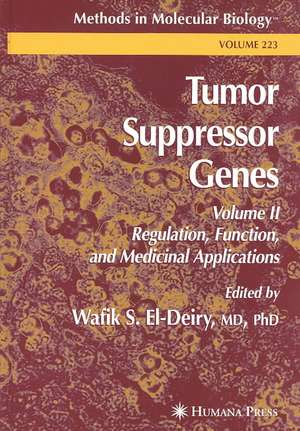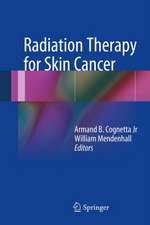Tumor Suppressor Genes: Volume 2: Regulation, Function, and Medicinal Applications: Methods in Molecular Biology, cartea 223
Editat de Wafik S. El-Deiryen Limba Engleză Hardback – 21 apr 2003
| Toate formatele și edițiile | Preț | Express |
|---|---|---|
| Paperback (1) | 811.37 lei 6-8 săpt. | |
| Humana Press Inc. – 9 oct 2013 | 811.37 lei 6-8 săpt. | |
| Hardback (2) | 1122.78 lei 6-8 săpt. | |
| Humana Press Inc. – 3 mar 2003 | 1122.78 lei 6-8 săpt. | |
| Humana Press Inc. – 21 apr 2003 | 1131.56 lei 6-8 săpt. |
Din seria Methods in Molecular Biology
- 9%
 Preț: 791.59 lei
Preț: 791.59 lei - 23%
 Preț: 598.56 lei
Preț: 598.56 lei - 20%
 Preț: 882.95 lei
Preț: 882.95 lei -
 Preț: 252.04 lei
Preț: 252.04 lei - 5%
 Preț: 802.69 lei
Preț: 802.69 lei - 5%
 Preț: 729.61 lei
Preț: 729.61 lei - 5%
 Preț: 731.43 lei
Preț: 731.43 lei - 5%
 Preț: 741.30 lei
Preț: 741.30 lei - 5%
 Preț: 747.16 lei
Preț: 747.16 lei - 15%
 Preț: 663.45 lei
Preț: 663.45 lei - 18%
 Preț: 1025.34 lei
Preț: 1025.34 lei - 5%
 Preț: 734.57 lei
Preț: 734.57 lei - 18%
 Preț: 914.20 lei
Preț: 914.20 lei - 15%
 Preț: 664.61 lei
Preț: 664.61 lei - 15%
 Preț: 654.12 lei
Preț: 654.12 lei - 18%
 Preț: 1414.74 lei
Preț: 1414.74 lei - 5%
 Preț: 742.60 lei
Preț: 742.60 lei - 20%
 Preț: 821.63 lei
Preț: 821.63 lei - 18%
 Preț: 972.30 lei
Preț: 972.30 lei - 15%
 Preț: 660.49 lei
Preț: 660.49 lei - 5%
 Preț: 738.41 lei
Preț: 738.41 lei - 18%
 Preț: 984.92 lei
Preț: 984.92 lei - 5%
 Preț: 733.29 lei
Preț: 733.29 lei -
 Preț: 392.58 lei
Preț: 392.58 lei - 5%
 Preț: 746.26 lei
Preț: 746.26 lei - 18%
 Preț: 962.66 lei
Preț: 962.66 lei - 23%
 Preț: 860.21 lei
Preț: 860.21 lei - 15%
 Preț: 652.64 lei
Preț: 652.64 lei - 5%
 Preț: 1055.50 lei
Preț: 1055.50 lei - 23%
 Preț: 883.85 lei
Preț: 883.85 lei - 19%
 Preț: 491.88 lei
Preț: 491.88 lei - 5%
 Preț: 1038.84 lei
Preț: 1038.84 lei - 5%
 Preț: 524.15 lei
Preț: 524.15 lei - 18%
 Preț: 2122.34 lei
Preț: 2122.34 lei - 5%
 Preț: 1299.23 lei
Preț: 1299.23 lei - 5%
 Preț: 1339.10 lei
Preț: 1339.10 lei - 18%
 Preț: 1390.26 lei
Preț: 1390.26 lei - 18%
 Preț: 1395.63 lei
Preț: 1395.63 lei - 18%
 Preț: 1129.65 lei
Preț: 1129.65 lei - 18%
 Preț: 1408.26 lei
Preț: 1408.26 lei - 18%
 Preț: 1124.92 lei
Preț: 1124.92 lei - 18%
 Preț: 966.27 lei
Preț: 966.27 lei - 5%
 Preț: 1299.99 lei
Preț: 1299.99 lei - 5%
 Preț: 1108.51 lei
Preț: 1108.51 lei - 5%
 Preț: 983.72 lei
Preț: 983.72 lei - 5%
 Preț: 728.16 lei
Preț: 728.16 lei - 18%
 Preț: 1118.62 lei
Preț: 1118.62 lei - 18%
 Preț: 955.25 lei
Preț: 955.25 lei - 5%
 Preț: 1035.60 lei
Preț: 1035.60 lei - 18%
 Preț: 1400.35 lei
Preț: 1400.35 lei
Preț: 1131.56 lei
Preț vechi: 1191.12 lei
-5% Nou
Puncte Express: 1697
Preț estimativ în valută:
216.52€ • 226.71$ • 179.59£
216.52€ • 226.71$ • 179.59£
Carte tipărită la comandă
Livrare economică 09-23 aprilie
Preluare comenzi: 021 569.72.76
Specificații
ISBN-13: 9780896039872
ISBN-10: 0896039870
Pagini: 657
Ilustrații: XIX, 657 p.
Dimensiuni: 178 x 254 x 37 mm
Greutate: 1.34 kg
Ediția:2003
Editura: Humana Press Inc.
Colecția Humana
Seria Methods in Molecular Biology
Locul publicării:Totowa, NJ, United States
ISBN-10: 0896039870
Pagini: 657
Ilustrații: XIX, 657 p.
Dimensiuni: 178 x 254 x 37 mm
Greutate: 1.34 kg
Ediția:2003
Editura: Humana Press Inc.
Colecția Humana
Seria Methods in Molecular Biology
Locul publicării:Totowa, NJ, United States
Public țintă
Professional/practitionerCuprins
Understanding the Function and Regulation of Tumor Suppressor Genes.- Utilizing NMR to Study the Structure of Growth-Inhibitory Proteins.- Generation and Application of Phospho-specific Antibodies for p53 and pRB.- Stability and Ubiquitination of the Tumor Suppressor Protein p53.- Role of Tumor Suppressors in DNA Damage Response.- In Situ Hybridization in Cancer and Normal Tissue.- Genetic Strategies in Saccharomyces cerevisiae to Study Human Tumor Suppressor Genes.- Electrophoretic Mobility Shift Analysis of the DNA Binding of Tumor Suppressor Gene Products.- Analysis of Gene Promoter Regulation by Tumor Suppressor Genes.- DNA Footprinting.- Identification of DNA-Binding of Tumor Suppressor Genes by Chromatin Immunoprecipitation.- Co-immunoprecipitation of Tumor Suppressor Protein-Interacting Proteins.- Microarray Approaches for Analysis of Tumor Suppressor Gene Function.- Analysis of Tumor Suppressor Gene-Induced Senescence.- Yeast Two-Hybrid Screening as a Means of Deciphering Tumor Suppressor Pathways.- Somatic Cell Knockouts of Tumor Suppressor Genes.- Colony Growth Suppression by Tumor Suppressor Genes.- Flow Cytometric Analysis of Cell Cycle Control by Tumor Suppressor Genes.- Analysis of Cyclin-Dependent Kinase Activity.- Tumor Suppressor Gene-Inducible Cell Lines.- In Vitro Models of Early Neoplastic Transformation of Human Mammary Epithelial Cells.- Tumor Suppression Through Angiogenesis Inhibition.- Flow Cytometric Analysis of Tumor Suppressor Gene-Induced Apoptosis.- Functional Analysis of Tumor Suppressor Genes in Mice.- The Tissue Microenvironment as an Epigenetic Tumor Modifier.- Analyzing the Function of Tumor Suppressor Genes Using a Drosophila Model.- Assembling a Tumor Progression Model.- Conformation-Sensitive Gel Electrophoresis for Detecting BRCA1Mutations.- Medicinal Applications of Tumor Suppessors.- Conversion Technology and Cancer Predispositions.- Discovering Novel Anticancer Drugs.- Targets in Apoptosis Signaling.- Tumor Deprivation of Oxygen and Tumor Suppressor Gene Function.- Hormonal and Differentiation Agents in Cancer Growth Suppression.- Regulation of NF-?B by Oncoproteins and Tumor Suppressor Proteins.- Blocking Survivin to Kill Cancer Cells.- Targeting the Mitochondria to Enhance Tumor Suppression.- Novel Approaches to Screen for Anticancer Drugs Using Saccharomyces cerevisiae.- Tumor Suppressor Gene Therapy.- Therapeutic Strategies Using Inhibitors of Angiogenesis.- Isolation of p53 Inhibitors by Screening Chemical Libraries in Cell-Based Readout System.
Recenzii
"The book will prove a great help to everybody who would like to enter the field of experimental and or clinical research. Those who are interested in basic understanding microbiology of cancer will enjoy this as well." -Neoplasma
Textul de pe ultima copertă
Powerful new tools are now available to discover and understand tumor suppressor genes (TSGs) and the biochemical mechanisms by which they control cancer development and progression. In Tumor Suppressor Genes, Volume 2: Regulation, Function, and Medicinal Applications, leading physician scientists and researchers explore the cell biology and biochemical function of the tumor suppressor genes, as well as their physiological role in vivo. The authors detail the physical methods-NMR, microarray approaches, posttranslational structure analysis, analysis of regulation at the gene expression and protein signaling levels-used to understand the function of tumor suppressor genes. In vivo approaches discussed include studies in yeast, Drosophila, mice, and human tumors. The authors also discuss how one ultimately derives a "tumor progression model," the drug discovery process, and the weaknesses of cancers that allow drugs to selectively kill them. Other aspects reviewed include screening strategies, targeting the blood supply of tumors, and the replacement of defective cancer genes to achieve a therapeutic effect. The companion volume of this set, Tumor Suppressor Genes, Volume 1: Pathways and Isolation Strategies, covers all known tumor suppressor genes, describing their cellular signaling pathways, how they were discovered, how they can be analyzed, and how they can be optimally used in cancer therapeutics
Comprehensive and authoritative, the two volumes of Tumor Suppressor Genes provide an unparalleled compilation of key data on all known tumor suppressor pathways and a treasury of techniques for their discovery, analysis, and uses in cancer therapeutics.
Comprehensive and authoritative, the two volumes of Tumor Suppressor Genes provide an unparalleled compilation of key data on all known tumor suppressor pathways and a treasury of techniques for their discovery, analysis, and uses in cancer therapeutics.
Caracteristici
Includes supplementary material: sn.pub/extras


















